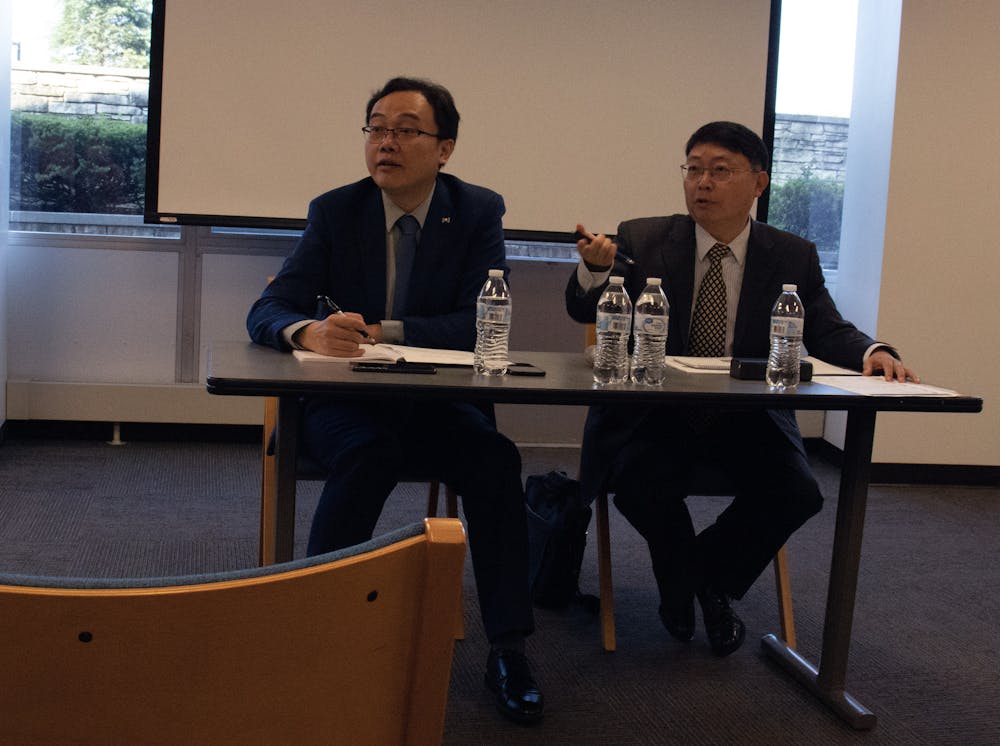Acting as a bridge: delegates from the Chinese Embassy visit CMU
On Aug. 9, two delegates from the Chinese embassy spoke on recovering the educational exchange program post-pandemic

About 30 students, staff, faculty and administrators filled the Mackinaw Room at the Bovee University Center, Wednesday, to talk building and strengthening relationships with institutions of higher education in the People's Republic of China. They were taking the opportunity to hear from two of that nation's top educational leaders.
Yun Zhang and AI Longfei made up a delegation from the Chinese Embassy that came to Central Michigan University’s campus on Aug. 9. Counselor Zhang is the embassy’s counselor of education; and Mr. AI is second secretary of education at the embassy in the U.S.
They visited to facilitate a conversation about the status of educational exchange programs between the United States and China.
Zhang explained a few reasons for a breakdown in educational cooperation and travel between the countries:
- A lack of direct flights from the U.S. to and from China, which fell from 330 to 24 post-pandemic.
- The pandemic itself, which made travel more of a safety risk.
- Presidential proclamation 10043, which dissuaded many Chinese students from attending American universities “for fear of being deported with a valid visa,” Zhang said.
He added that “national security could be easily used as a reason to obstruct normal educational exchanges.”
But he also saw a light at the end of the tunnel. Zhang identified a sharp increase in joint educational programs, going from 320 to 370 between 2022 and 2023. He also said there are three key ways the two countries can move forward in their working relationship:
- Emphasizing the value of open research.
- Promoting reciprocal or balanced mobility between the countries and their programs.
- Making strategic plans and long-term commitment to a continued relationship.
AI said there is more interest now than before the pandemic from Chinese students wanting to study abroad, and advised that if a university wanted to attract those students, it should start advertising to them at places like educational fairs in China.
In attendance at the event was CMU Vice President of Student Affairs Renee Watson, who asked what American universities can do to support Chinese students.
Mr. AI suggested making the transition easier in a few ways, mainly by creating opportunities for cultural exposure and social growth. Counselor Zhang added that it would be helpful to provide “tip sheets” in Mandarin to students identifying common mistakes or problems to be avoided.
Another factor in attracting students to a university is the school’s ranking.
“As for the parents, they do not know which schools are good,” AI said, explaining that while there are a lot of factors that can be used to judge a school, rankings are what most families in China have access to.
More Chinese students have the advantage of being exposed to or having access to the English language, but American students tend not to learn Mandarin, making it less likely for Americans to attend Chinese colleges.
Zhang pointed out that there are plenty of reasons an American student should be motivated to study in China, describing their economy as vibrant, energetic and innovating.
“China is the second largest economy in the world,” Zhang said. “More and more students realize the importance of understanding Chinese history and culture, which has been documented for 3,000 years.”
Right now, there are less than 50 Chinese exchange students at CMU, according to the Office of International Recruitment. One of those students is Xiaobai Chen, who is working on a master’s degree in applied statistics.
He said he attended the event simply because the signs around the University Center caught his attention, but he doesn’t think a rebalancing will come as easily as the delegates described.
“The bilateral tension is still there, although we keep talking every day,” Chen said. “There’s no real possibility of resolving these problems.”
He explained that there’s always going to be a larger number of Chinese students interested in American schools than American students interested in Chinese schools because of the prestige and name recognition of American institutions.
“If they do research in China, they have a limited database,” Chen said.
He also approximated that Chinese students have 10 times as may English resources as Americans do Mandarin.
Before the end of his presentation, Zhang added a caveat.
“Many of the issues I mentioned are systemic, and not much can be done at the (educational) level,” he said. But he recommended incentivizing study abroad programs to create a snowball effect of positive experiences that are repeated and recommended to peers.
He also said his office is a continuing resource for expanding connections.
“We will act as a bridge to promote mutual understanding,” Zhang said.






